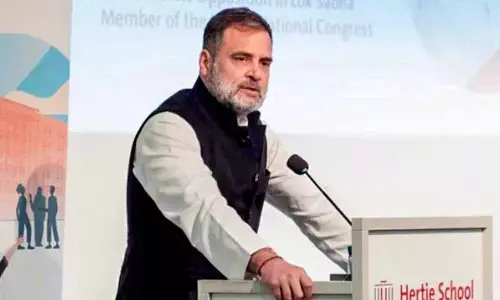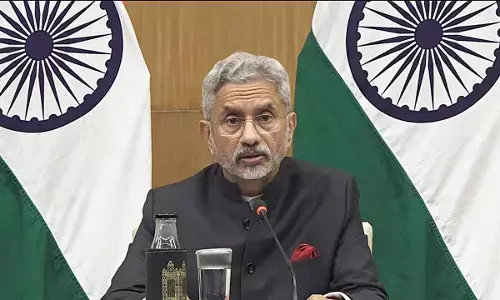Indian Nuclear Energy Programme

India’s three-stage nuclear power programme was formulated by Homi Bhabha in 1950’s to secure the country’s long term energy independence, through the use of uranium and thorium reserves found in the monazite sands of coastal regions of South India.
India’s Three-Stage Nuclear Power Programme
India’s three-stage nuclear power programme was formulated by Homi Bhabha in 1950’s to secure the country’s long term energy independence, through the use of uranium and thorium reserves found in the monazite sands of coastal regions of South India.
The ultimate focus of the programme is on enabling the thorium reserves of India to be utilized in meeting the country’s energy requirements.
• Thorium is particularly attractive for India, as it has only around 1–2% of the global uranium reserves, but one of the largest shares of global thorium reserves.
• However, at present thorium is not economically viable because global uranium prices are much lower.
• The Indo-US Nuclear Deal and the NSG waiver, which ended more than three decades of international isolation of the Indian civil nuclear programme, have created many hitherto unexplored alternatives for the success of the three-stage nuclear power programme.
• Thorium itself is not a fissile material, and thus cannot undergo fission to produce energy.
• Instead, it must be transmuted to uranium-233 in a reactor fueled by other fissile materials [plutonium-239 or uranium-235].
• The first two stages, natural uranium-fueled heavy water reactors and plutonium-fueled fast breeder reactors, are intended to generate sufficient fissile material from India’s limited uranium resources, so that all its vast thorium reserves can be fully utilized in the third stage of thermal breeder reactors.
The three stages are as follows
1. Pressurized heavy water reactor (PHWR)
2. Fast breeder reactor (FBR)
3. Advanced Heavy Water Reactor(AHWR)
Stage I – Pressurized Heavy Water Reactor [PHWR]
In the first stage, natural uranium fuelled pressurized heavy water reactors (PHWR) is used to produce electricity while generating plutonium-239 as by-product.U-238 Plutonium-239 + Heat In PWHR, enrichment of Uranium to improve concentration of U-235 is not required. U-238 can be directly fed into the reactor core.
Natural uranium contains only 0.7% of the fissile isotope uranium-235. Most of the remaining 99.3% is uranium-238 which is not fissile but can be converted in a reactor to the fissile isotope plutonium-239.Heavy water (deuterium oxide, D 2O) is used as moderator and coolant in PHWR.
Logic behind Stage 1
1. The first stage involved using natural uranium to fuel PHWR to produce electricity and producing Plutonium-239 as a byproduct. We note here that the PHWRs were chosen for the first stage because in 1960s, India had the efficient reactor design in terms of uranium utilisation. It was calculated that rather than going for creation of Uranium Enrichment Facilities, it would be wiser to create heavy water production facilities.
2. Moreover, using Pressurized Heavy Water Reactors rather than Light Water Reactors (LWR) was also a correct and wise decision. While Pressurized Heavy Water Reactors used unenriched uranium, Light Water Reactors required enriched uranium. Further, India could domestically produce the components of PWHR, as opposed to LWRs. Furthermore the byproduct plutonium-293 would be used in the second stage.
Stage II – Fast Breeder Reactor
• In the second stage, fast breeder reactors (FBRs)[moderators not required] would use plutonium-239, recovered by reprocessing spent fuel from the first stage, and natural uranium.
• In FBRs, plutonium-239 undergoes fission to produce energy, while the uranium-238 present in the fuel transmutes to additional plutonium-239.
Why should Uranium-238 be transmuted to Plutonium-239?
Uranium-235 and Plutonium-239 can sustain a chain reaction. But Uranium-238 cannot sustain a chain reaction. So it is transmuted to Plutonium-239.
But Why U-238 and not U-235?
Natural uranium contains only 0.7% of the fissile isotope uranium-235. Most of the remaining 99.3% is uranium-238.
• Thus, the Stage II FBRs are designed to “breed” more fuel than they consume.
• Once the inventory of plutonium-239 is built up thorium can be introduced as a blanket material in the reactor and transmuted to uranium-233 for use in the third stage.
• The surplus plutonium bred in each fast reactor can be used to set up more such reactors, and might thus grow the Indian civil nuclear power capacity till the point where the third stage reactors using thorium as fuel can be brought on line.
Logic behind Stage 2:
1. FBR The second stage involves using plutonium-239 to produce mixed-oxide fuel, which would be used in Fast Breeder Reactors. Plutonium 293 undergoes fission to produce energy, and metal oxide. Enriched uranium reacts with mixed-oxide fuel to produce more plutonium-239.
2. Furthermore once a sufficient amount of plutonium-239 is built up, thorium will be used in the reactor, to produce Uranium-233. This uranium is crucial for the third stage.
Stage III – Thorium Based Reactors
• A Stage III reactor or an Advanced nuclear power system involves a self-sustaining series of thorium-232-uranium-233 fuelled reactors.
• This would be a thermal breeder reactor, which in principle can be refueled – after its initial fuel charge – using only naturally occurring thorium.
Logic behind Stage 3
1. AHWR The main purpose of stage-3 is to achieve a sustainable nuclear fuel cycle. The advance nuclear system would be used a combination of Uranium-233 and Thorium. Thus India’s vast thorium would be exploited, using a thermal breeder reactor.
2. Thorium use was reserved for the last stage because despite having significant availability, use of Thorium in production of energy has been full of certain challenges. It cannot be used directly. Since it is a fertile material, it can be only used with added fissile material that can be enriched Uranium, Plutonium or Uranium-233 (obtained after irradiation of Thorium).
Thorium absorbs the neutrons, which can more efficiently produce more Plutonium in Fast Breeder Reactor for a faster growth. Therefore, using Thorium in the first, or an early part of second stage of nuclear power programme will adversely affect the rate of growth of nuclear power generation capacity in the initial periods.
Due to these reasons, large scale deployment of Thorium was postponed till the later part of the second stage. Thorium is to be introduced only at an optimal point during operation of Fast Breeder Reactors in the second stage.
Thorium, for power generation is to be used mainly in the third stage. Thus, the ultimate objective of the above programme is to create capacity to use Thorium for sustainable production of nuclear energy and make India energy independent.
What is a fissile material?
• A fissile material is one that can sustain a chain reaction upon bombardment by neutrons.
• Thorium s by itself fertile, meaning that it can transmute into a fissile radioisotope [U-233] but cannot itself keep a chain reaction going.
• In a thorium reactor, a fissile material like uranium or plutonium is blanketed by thorium.
• The fissile material, also called a driver in this case, drives the chain reaction to produce energy while simultaneously transmuting the fertile material into fissile material.
By Vital Reddy
















